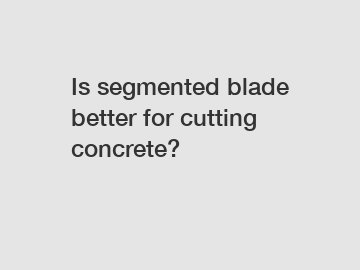Is segmented blade better for cutting concrete?
Apr. 07, 2024
Concrete cutting is a common practice in the construction industry, and having the right tools for the job is essential for achieving optimal results. One of the most important tools in concrete cutting is the blade used for the job. When it comes to cutting concrete, there are several different types of blades available, including segmented blades. But is segmented blade better for cutting concrete? Let's delve deeper into this topic.
Segmented blades are designed with small segments that are attached to the core of the blade. These segments contain diamond grit, which is known for its hardness and ability to cut through tough materials like concrete. The segments are separated by gaps, allowing for better cooling and debris removal during the cutting process. This design helps to prevent overheating and prolong the life of the blade.
One of the main advantages of segmented blades is their ability to cut through hard materials like concrete with ease. The diamond grit on the segments is incredibly tough and can withstand the high temperatures and pressures that come with cutting through concrete. This results in faster and more efficient cutting, saving both time and effort on the job.

Segmented blades are also known for their versatility. They can be used on a variety of materials, including concrete, brick, block, and stone. This makes them a popular choice among contractors who work with different types of materials on a regular basis. Whether you are cutting through a thick slab of concrete or making precise cuts on a delicate stone surface, a segmented blade can get the job done.
In addition to their cutting capabilities, segmented blades are also known for their durability. The diamond grit on the segments is extremely hard and wear-resistant, allowing the blade to last longer than other types of blades. This means fewer blade changes and less downtime on the job, ultimately saving you money in the long run.
Another benefit of segmented blades is their cost-effectiveness. While they may have a higher upfront cost compared to other types of blades, their durability and efficiency make them a cost-effective choice in the long run. They can last longer and cut faster than traditional blades, reducing the need for frequent replacements and ultimately saving you money over time.
However, segmented blades are not without their drawbacks. One of the main disadvantages of segmented blades is their tendency to produce rougher cuts compared to other types of blades. The gaps between the segments can leave behind rough edges on the material being cut, which may require additional finishing work to achieve a smooth surface. This can be a drawback for projects that require a high level of precision and a smooth finish.
Despite this drawback, segmented blades remain a popular choice for cutting concrete due to their speed, efficiency, durability, and versatility. They are a reliable tool for contractors who need to cut through tough materials on a regular basis and are looking for a cost-effective solution.
In conclusion, segmented blades can be a better choice for cutting concrete due to their cutting capabilities, durability, versatility, and cost-effectiveness. While they may produce rougher cuts compared to other blades, their overall performance and efficiency make them a valuable tool for contractors in the construction industry. So, if you are in need of a reliable and efficient blade for cutting concrete, consider using a segmented blade for your next project.
Want more information on turbo vs continuous diamond blade, continuous rim vs segmented diamond blade, segmented cutting disc? Feel free to contact us.
90
0
0


Comments
All Comments (0)